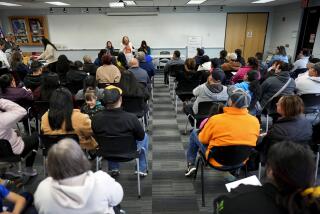U.S. to investigate Secure Communities deportation program
The Department of Homeland Security’s Office of Inspector General plans an investigation of an immigration enforcement program that purports to target “serious convicted felons” for deportation but has ensnared many illegal immigrants who were arrested but not subsequently convicted of crimes or who committed minor offenses, a letter obtained Wednesday shows.
The letter from acting Inspector General Charles K. Edwards to Rep. Zoe Lofgren (D-San Jose), who requested an investigation late last month, said the watchdog agency had already scheduled a review of the program, known as Secure Communities. Homeland Security’s Immigration and Customs Enforcement agency launched the program in 2008 with plans for mandatory nationwide participation by 2013.
The review, Edwards wrote, aims to “determine the extent to which ICE uses the program to identify and remove dangerous criminal aliens from the United States.”
It will also examine cost, “the accuracy of ICE’s data collection,” whether the program is being applied equitably across communities, and the way ICE officials portrayed the program to states and counties, which were initially told they could opt out but were later informed that participation has always been mandatory.
Under the program, fingerprints routinely sent by local jails to the FBI for criminal background checks are shared with ICE. Although local law enforcement does not actively participate, the program has turned jails in about 1,200 U.S. counties into immigration screening centers. All 58 California counties are on board, though San Francisco and Santa Clara sought unsuccessfully to opt out.
Proponents, including Los Angeles County Sheriff Lee Baca, say the program is successfully targeting serious threats to public safety. According to ICE, about 28,000, or 35%, of the people deported so far had been convicted of felonies including murder and rape. An unknown number who appear in ICE data on the program as “noncriminals” or as having committed only misdemeanors had prior violent felonies here or in their home countries, or were previously deported and returned illegally, they note.
But opponents contend that by also sweeping up minor offenders or those never convicted of crimes, the program is dissuading illegal immigrants from cooperating with law enforcement.
ICE data show that about half those flagged for deportation since the program began were not convicted after their arrest or were convicted of misdemeanors. Immigrant rights groups also say the program has encouraged racial profiling, an allegation that recently prompted Homeland Security officials to hire an outside statistician to analyze the arrest data.
Secure Communities “has been shrouded in secrecy and we hope that the OIG takes a real and serious look at all aspects of its operation,” said Melissa Keaney, an attorney with the National Immigration Law Center.
The organization requested an Office of Inspector General audit of the program last fall and was told one would be conducted.
The program has been particularly controversial over the issue of whether local governments could opt out. Officials initially said it was voluntary but now maintain that it will be operating in all states and counties by 2013 regardless of opposition. In seeking an investigation last month, Lofgren bluntly accused ICE officials of lying to local governments and to members of Congress.
In a response to the congresswoman, ICE Director John Morton pointed the finger in part at private contractor Dan Cadman. Cadman was terminated in March after emails released in response to litigation showed that he told New York officials that opting out was possible and suggested that pressure be applied to Cook County, Ill., officials to bring them on board with the program. His were among hundreds of internal ICE emails released.
ICE, Morton told Lofgren, “takes full responsibility for the confusion and the inconsistent statements the agency has made about participation in the program.” Steps taken to address the issue, he added, included “the termination of a contractor who authored several unacceptable emails.”
However, the released emails indicate that knowledge of the deceptive messaging went much higher than Cadman, a point the contractor makes in a May 9 letter to Lofgren obtained Wednesday by The Times. In it, Cadman claims he has become a scapegoat for higher-ups who are responsible for the confusion. In his correspondence, Cadman included an April letter to Secure Communities Acting Assistant Director Marc Rapp that supports his assertions.
“ICE painted itself into a corner and needed someone to blame,” Cadman wrote. “I think you will agree after reading my letter that confusion over opting out of Secure Communities has arisen not because of me, but because of the government’s own vacillation, policy shifts and inconsistent public stances.”
In his letter to Rapp, Cadman notes his recommendations in 2009 and early 2010 that ICE be clear with local officials about the lack of an opt-out but says they were rejected by higher-ups. “I faithfully put forward the government’s often shifting positions, as best I understood them, even when I did not personally agree with them,” he wrote. Reached Wednesday, he declined to comment.
The ICE press office also declined to comment on the Cadman correspondence and said that “as a matter of policy we do not comment on pending IG reviews.”
Legislation pending in California would modify the state’s agreement with ICE in part to apply the program only to convicted felons. If ICE does not agree to the changes, the legislation would require California to withdraw from the program.
Illinois’ governor this month terminated that state’s agreement with ICE after unsuccessfully seeking similar modifications. And on Wednesday, program opponents protested in front of the office of New York Gov. Andrew Cuomo urging him to take similar action.
More to Read
Start your day right
Sign up for Essential California for news, features and recommendations from the L.A. Times and beyond in your inbox six days a week.
You may occasionally receive promotional content from the Los Angeles Times.







